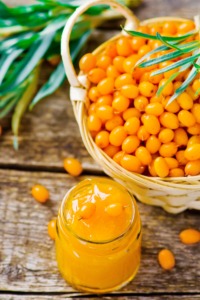One of the main components in dry sea buckthorn fruits is the carbohydrates class. Recent researches have showed total carbohydrates content in the range of 400 and 600 g/kg dry weight.
The soluble sugar content varies from 9.3 to 22.74°Brix for sea buckthorn juice. This variation is due to the time of harvesting the fruits, respectively, their degree of ripeness. They can be harvested in autumn, at full maturity, or in winter, after the fruit freezes. Additionally, the sugar content varies depending on the origin and genetic background of the plant.
The sugar content in sea buckthorn berries varies in the range 27–58 g/kg DW and increases during ripening of the berries. A total of 90% of sugars in Chinese and Russian varieties are glucose and fructose, as against the Finnish varieties where glucose and fructose sum 60% of sugars. When comparing subspecies, the sinensis one was found to have the highest sugars content in sea buckthhorn pulp juice, up to a level of 105 ± 36 g/L.
Generally, the carbohydrates contained in sea buckthorn fruits are mostly glucose and fructose, with small amounts of xylose, mannitol, sorbitol, xylitol, ethyl glucose and saccharose. It was also found a methyl inositol and ethyl glucose in sea buckthorn berries. Cyclitol plays a potential role in scavenging hydroxyl radicals.
sorbitol, xylitol, ethyl glucose and saccharose. It was also found a methyl inositol and ethyl glucose in sea buckthorn berries. Cyclitol plays a potential role in scavenging hydroxyl radicals.
Together with organic acids, sugars may effectively influence the sensory properties of sea buckthorn berries, which play an important role in market acceptance by consumers. As sea buckthorn berries have a low sugar content and a high titratable acidity, an important factor in improving the flavor of sea buckthorn berries is a high sugar/acid ratio, which varies by changes in latitude and altitude of geographic location.
Besides, one of the important health benefits of sea buckthorn is high fiber content, which varies depending on weather conditions and maturity of the berries. The level of crude fiber in sea buckthorn is between 62 g/kg dry weight and 100 g/kg dry weight. The dietary fibers fractions in sea buckthorn fruits are distributed as follows: 160–200 g/kg dry weight neutral detergent fiber, 120–145 g/kg dry weight acid detergent fiber, 50–70 g/kg dry weight acid detergent lignin, 45–55 g/kg dry weight hemicellulose, and 60–75 g/kg dry weight cellulose.
The polysaccharides of sea buckthorn fruits are an especially non-starchy type of polysaccharides, composed of cellulose, hemicelluloses, pectin, and hydrocolloids that are together with lignin the major constituents of dietary fiber. Only sea buckthorn seeds contain starch, a dietary polysaccharide with high digestibility in the human small intestine, in an amount of 49 g/kg dry weight. Both sea buckthorn peel and pulp contain pectin, in much smaller quantities of 5 g/kg dry weight and 15 g/kg dry weight, respectively. The content of raw fiber in seeds was 130 g/kg dry weight, in peel 66 g/kg dry weight, and in pulp 47 g/kg dry weight.

Leave A Comment